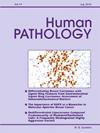骨骼肌标志物在骨化纤维黏液样瘤中的表达:44例肿瘤的研究。
IF 2.6
2区 医学
Q2 PATHOLOGY
引用次数: 0
摘要
骨化性纤维黏液样肿瘤(OFMT)是一种罕见的间充质肿瘤,具有可变的恶性潜能,其免疫表型通常被描述为desmin和S100的共同表达。自其最初的描述,相当多的努力已被用来充分表征OFMT的免疫表型。由于一个组织学上经典的OFMT的会诊病例,其中desmin表达伴随着骨骼肌特异性核调节蛋白MyoD1的表达,我们检查了44例OFMT中MyoD1和肌原蛋白表达的频率。在44例病例中,有23例(52%)存在MyoD1表达,而没有一例肌原蛋白阳性。MyoD1在20/31(65%)的desmin阳性肿瘤中表达,而desmin在20/23(87%)的MyoD1阳性肿瘤中表达。5例患者PAX7染色,1例恶性OFMT呈弱表达。据我们所知,这是OFMT中横纹肌母细胞标记物表达的首次正式研究。本文章由计算机程序翻译,如有差异,请以英文原文为准。
Skeletal muscle marker expression in ossifying fibromyxoid tumor: A study of 44 tumors
Ossifying fibromyxoid tumor (OFMT) is a rare mesenchymal neoplasm harboring variable malignant potential and showing an immunophenotype classically described as co-expression of desmin and S100. Since its original description, considerable effort has been employed to fully characterize the immunophenotype of OFMT. Prompted by a consultation case of a histologically classic OFMT in which desmin expression was accompanied by expression of the skeletal muscle-specific nuclear regulatory protein MyoD1, we examined the frequency of MyoD1 and myogenin expression in a series of forty four cases of OFMT. Of the 44 cases, MyoD1 expression was present in 23 (52 %) cases, while none were myogenin-positive. MyoD1 expression was found in 20/31 (65 %) desmin-positive tumors, whereas desmin expression was present in 20/23 (87 %) MyoD1-positive tumors. A subset of five cases were stained for PAX7, and a single case of malignant OFMT showed weak expression. To our knowledge, this is the first formal study of rhabdomyoblastic marker expression in OFMT.
求助全文
通过发布文献求助,成功后即可免费获取论文全文。
去求助
来源期刊

Human pathology
医学-病理学
CiteScore
5.30
自引率
6.10%
发文量
206
审稿时长
21 days
期刊介绍:
Human Pathology is designed to bring information of clinicopathologic significance to human disease to the laboratory and clinical physician. It presents information drawn from morphologic and clinical laboratory studies with direct relevance to the understanding of human diseases. Papers published concern morphologic and clinicopathologic observations, reviews of diseases, analyses of problems in pathology, significant collections of case material and advances in concepts or techniques of value in the analysis and diagnosis of disease. Theoretical and experimental pathology and molecular biology pertinent to human disease are included. This critical journal is well illustrated with exceptional reproductions of photomicrographs and microscopic anatomy.
 求助内容:
求助内容: 应助结果提醒方式:
应助结果提醒方式:


